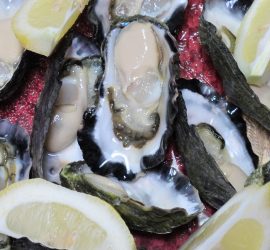Blue cod

Unique to New Zealand coastal waters, this is not related to the English sablefish, which is also known as blue cod. More common around the South Island, it is a highly treasured fish and the absolute fish of choice when ordering fish and chips here. With little oil and firm flakes it is just perfect crumbed and fried.
Is is a popular target for recreational fishers as it can be found in shallow waters down to a depth of 30kg, and can grow to 60cm and 3kg. It is a home ranging fish and unfortunately has been heavily fished in some areas around the Marlborough Sounds although stocks are quite healthy further south. An intelligent and curious fish, it can come very close to divers and snorkelers and has a reputation for nibbling the odd finger or ear from time to time.
Blue cod are caught with hooks and lines, by spearfishing, and by the use of fish traps or ‘pots’. Fisheries New Zealand closely monitors stock levels and puts controls on both commercial and recreational fishing when necessary.
Pāua (Abalone)

Abalone, known here as pāua, have a special place in New Zealand culture. They have been hunted for centuries by skilled divers in cool coastal waters amongst the kelp beds and rocky inshore reefs. Their beautiful mother-of-pearl shells have also been used in traditional carvings and artwork. Available in most fish and chips shops as fritters, the firm tasty meat is also spectacular thin-sliced and pan fried.
Pāua are found all around New Zealand from a depth of 1-10 metres. There are three major species here, blackfoot pāua, yellowfoot pāua, and whitefoot pāua. Extremely popular in Asia where almost all commercially harvested pāua are sent, a pāua can cost you $US100, and here a recreational diver is allowed to take 10 of them in a day so predictably there is a significant black market and a fair amount of poaching activity.
There is very active monitoring and regular review of regulations associated with the taking of abalone nation-wide, and recreational divers may only take them by free diving, without the benefit of scuba or other breathing equipment.
There is also a very successful pāua aquaculture industry which produces both meat and mother-of-pearl shell. In fact cultivation of beautiful pāua pearls is also undertaken, similar to other pearl cultivation.
Rock Lobster

Although there is confusion about the correct name, in reality everyone knows what you are talking about when you use any of the terms “cray”, “crayfish”, or “lobster” in New Zealand and the Maori name for them is ‘koura’. More correctly they are also know as marine crayfish or rock lobster and very distinct from Atlantic lobsters which have claws. What everyone really wants to know is where are they, and although boasting about catching crayfish is a national pastime, telling people where they are caught is definitely not, except in very general terms. Divers protect their secret spots and understandably so. Any kind of lobster is usually delicious, and rock lobsters are no exception. The meat is firm and can be included in so many different kinds of recipes, but when they are fresh it’s hard to go past the simplest of methods boiling, steaming or barbequed with lots of butter involved.
New Zealand has a very productive rock lobster fishery, for commercial and recreational fishers. By far the most common lobster here is the red rock lobster, known as a southern rock lobster in Australia. They are found along rocky coastlines with plenty of wave and current action, and amongst kelp and weed beds. Often located by divers in crevices, they can gather in groups of up to 50 where they wait in hope of coming across tiny morsels in the water until nighttime when they venture from cover to hunt and scavenge more actively.
Commercial fishers have dropped lobster pots along the coast of New Zealand for many decades, and before them rock lobsters were an important resource for Maori over a much longer period. Fishing pressure did take its toll on the fishery up to the 1970s due to the huge number of boats from New Zealand and elsewhere over exploiting the fishery. With regulations, stricter licensing requirements, and quota systems progressively imposed, the fishery has now recovered and rock lobsters are again an important export and an important aspect of recreational fishing especially for divers.
Another rock lobster found here is the ‘packhorse’ lobster, which is a much bigger lobster than the red rock and is largely dark green in colour. Although common along the east coast of New South Wales in Australia where it is known as the eastern green lobster, it is rare here and becoming even rarer so taking them is discouraged.

